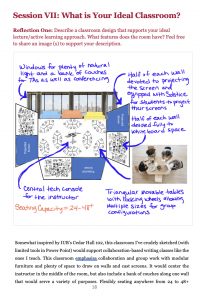In today’s blog, we want to share our updated version of a Mosaic reflective portfolio. The reflective portfolio is an artifact that each Mosaic Fellow creates, piece by piece, through their tenure in the Mosaic Fellows Program. In a previous blog, we shared an anonymized example of our first version of the portfolio. Since then, we’ve improved on our original design. In this blog, we highlight the key components of our new Mosaic portfolio.
Check out our anonymized version of our new Mosaic Portfolio here: 2021Anonymized-Mosaic-Portfolio
The Portfolio
At the close of each of our Mosaic Fellows meetings, we ask the Fellows to write reflections to provided written prompts. The written prompts are focused on the shared readings, discussion, and activities Fellows experience during or before each meeting. Once the final Mosaic meeting ends, we gather the Fellows’ responses, organize them into a portfolio, and add highlights from the program, including lists of participants, photos of meetings, a reading list, an opening letter, and other documents.
Intended Audience for the Portfolio
- The Fellows themselves: The portfolio serves as a lasting reminder of their experiences in the Mosaic Fellows program. The portfolio allows them to revisit concepts they encountered and their reactions to all aspects of the program. The portfolio also provides Fellows a resource to draw from for the future. When Fellows need to write a Teaching Statement or add to their teaching dossier, they can draw from or build on their own writings created in the portfolio.
- Tenure and Promotion (and other) committees: Fellows can add the portfolio to their teaching dossier to provide examples for teaching excellence. The updated, more formal look and make-up of the portfolio is geared toward an audience of administrators.
The Mosaic Fellows reflective portfolio is made of seven distinct parts:
- Intro Letter – We open the portfolio with an introduction letter describing the Mosaic Fellows Program. This letter is directed to readers who might not be familiar with the Mosaic Fellows program. The letter also thanks the Fellow by name for participating.
- Table of Contents – Next, we have a table of contents with session themes and prompts related to those themes. This table of contents is meant to provide a brief overview of topics and direct readers to appropriate pages.
- Prompts and Responses – This part represents the bulk of the Mosaic portfolio. The responses to each prompt contain text and imagery generated by the faculty members.
- Images From Our Sessions – We include images from some of our sessions to remind Fellows of the many collaborations with their peers.
- Reading List – All readings from the Mosaic program from the year are included in the reading list. Including the reading list in the portfolio provides a ready reference for Fellows’ future research projects.
- List of Participants – We end with a list of the participants from the cohort highlighting the many disciplines they represent.
- List of Readings – We end with a reading list to remind any audience who reads through the portfolio that the Mosaic Fellows program is rooted in research. The reading list also serves as a reference of key learning spaces literature to support any future Mosaic Fellow-led research efforts.

Our portfolios have been a big hit with the faculty:
“The portfolio is an important artifact that nicely demonstrates what I have learned from readings and inspirations I’ve got from discussion with peer fellows. The carefully designed prompts guide me to better understand key issues such as space and learning, active learning, and collaborative technologies. And the final product of the portfolio itself is a beautiful artifact of this rewarding and transformative experience.” — Yingling Bao, senior lecturer, Department of East Asian Languages and Cultures
Please Share Your Ideas
As we continue to evolve our approach to creating a reflective portfolio with faculty, we’d love to hear your ideas. If you have a portfolio you would like to share? If so, please do so in the comments below.

This work is licensed under a Creative Commons Attribution-NonCommercial-ShareAlike 4.0 International License.

Leave a Reply